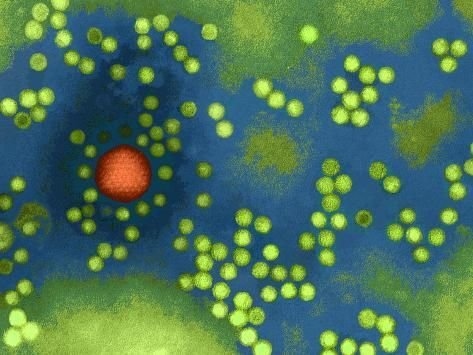
Introduction to AAV Virus
Definition and Characteristics
The adeno-associated virus (AAV) is a small, non-enveloped virus that belongs to the Parvoviridae family. It is a single-stranded DNA virus that requires a helper virus, such as adenovirus or herpesvirus, to replicate in host cells. AAV is known for its ability to infect humans and other primates but is not associated with any known diseases, making it a popular tool in gene therapy research. Its small size, simple structure, and low pathogenicity make it a promising candidate for delivering gene therapy vectors into cells safely and efficiently.
History and Discovery
AAV was first discovered as a contaminant in adenovirus preparations in the 1960s. Initially considered non-pathogenic and replication-defective, researchers later realized its potential as a gene therapy vector due to its ability to insert genetic material into host cells without causing disease. Over the years, AAV has gained significant attention in the field of molecular biology and gene therapy for its unique characteristics and versatile applications in research and clinical settings.
Structure and Genome of AAV Virus
Capsid Proteins
The structure of the AAV virus is primarily composed of three structural proteins, VP1, VP2, and VP3. These capsid proteins play crucial roles in viral entry, antigenicity, and host cell specificity. VP1, VP2, and VP3 are encoded by the viral genome and assemble to form the icosahedral capsid that protects the viral DNA during transmission and infection. Understanding the interactions between these capsid proteins is essential for manipulating the virus for gene delivery purposes.
Replication and Life Cycle
The replication of AAV virus is dependent on the presence of a helper virus, typically adenovirus or herpesvirus. Once inside a host cell, AAV utilizes the helper virus’s machinery to replicate its DNA and produce viral progeny. The virus can exist in both a lytic and lysogenic phase, providing versatility in its life cycle. AAV’s ability to establish latent infections in host cells contributes to its use as a gene therapy vector, as the viral genome can persist in the host cell for an extended period without causing harm. Understanding the intricacies of AAV’s replication and life cycle is crucial for harnessing its potential in gene therapy and molecular biology research.
Types and Serotypes of AAV Virus
The AAV virus, or Adeno-Associated Virus, exhibits various types and serotypes that play important roles in gene therapy and molecular biology research. Among the common serotypes are AAV1 to AAV9, each with distinct characteristics and tropism for different host cells. These serotypes are frequently utilized in gene delivery systems due to their stability and low immunogenicity, making them valuable tools in medical research.
Common Serotypes
On the other hand, emerging serotypes such as AAVrh32.33 and AAV-DJ have shown promising features for targeted gene therapy applications. These novel serotypes offer enhanced transduction efficiency and the ability to evade pre-existing immunity in patients, opening up new possibilities for gene therapy treatments.
Emerging Serotypes
Understanding the diversity of AAV types and serotypes is essential for researchers and scientists looking to optimize gene delivery strategies and develop more effective treatments for genetic disorders. By harnessing the unique characteristics of each serotype, the field of gene therapy continues to advance towards safer and more efficient methods of treating various diseases at the molecular level.
Transmission and Spread of AAV Virus
When it comes to the transmission and spread of the AAV virus, researchers and scientists must delve deeper into understanding the various pathways and factors that influence its behavior. The routes of transmission for AAV include mechanisms such as respiratory droplets, blood transfusions, and maternal-fetal transfer. These pathways play a crucial role in how the virus is disseminated and infects host cells.
Routes of Transmission
Factors affecting the spread of the AAV virus involve aspects like host immunity, environmental conditions, and viral vector design. Host immune responses can either aid or hinder the spread of the virus within a population. Environmental factors such as temperature and humidity can impact the virus’s stability outside a host. Additionally, the design of viral vectors used in gene therapy treatments can influence how efficiently the virus spreads and delivers genetic material to target cells.
Factors Affecting Spread
By comprehensively studying the routes of transmission and factors affecting spread, researchers can develop strategies to control and optimize the use of the AAV virus in gene therapy and molecular biology applications. This knowledge is crucial for advancing gene delivery techniques and enhancing the efficacy of treatments for genetic disorders.
Also Read: Understanding the Role of Adeno Associated Virus in Gene
Diseases Associated with AAV Virus
When exploring the diseases associated with the AAV virus, researchers acknowledge its significant role in various gene therapy applications. By utilizing AAV vectors, scientists can deliver therapeutic genes into targeted cells to address genetic disorders effectively. This innovative approach shows promise in treating conditions such as muscular dystrophy, hemophilia, and certain types of blindness caused by genetic mutations.
Gene Therapy Applications
On the other hand, it is crucial to consider potential risks and side effects associated with AAV-based gene therapy. While the use of AAV vectors offers precision in gene delivery, there are risks of immune responses triggering adverse reactions in some patients. Moreover, AAV vectors may induce unintended immune responses or integrate into the host genome, posing potential long-term health concerns.
Potential Risks and Side Effects
Researchers and medical professionals must carefully balance the benefits of AAV virus utilization in gene therapy with the potential risks to ensure patient safety and treatment efficacy. Continued research and advancements in genetic technologies will further enhance our understanding of the AAV virus’s role in disease treatment and prevention.
